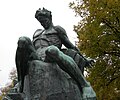Carl Eldh

Carl Eldh (May 10, 1873 – January 26, 1954) was a Swedish artist and sculptor. Full name: Carl Johan Eldh (signs on artwork as "C.J. ELDH"). Older brother to Albert Eldh.
Eldh came from the Swedish Uppland, the son of a blacksmith. From 1897 through 1904 he studied sculpture at the Académie Colarossi in Paris, where the French sculptor Auguste Rodin inspired him greatly. His first works were characterized by softer forms, but by 1916 he had developed a powerful realistic style, as with the Strindberg Monument in Tegnérlunden in Stockholm. Strindberg was a frequent subject for Eldh.

Carl Eldh ranks along Carl Milles with the most popular Swedish sculptors of the first half of the 20th Century. Eldh also produced architectural sculpture with renowned Swedish architects, among them Ivar Tengbom, Erik Lallerstedt and Ragnar Östberg. Östberg designed Eldh's own studio in Bellevue Park, in the north of Stockholm, in 1918. And through Östberg, Eldh received the 1923 contract for park sculptures for the Stadshuspark.
Adjacent to Stockholm City Hall, between the building and the shore of Lake Mälaren's shore, the park stands with Eldh's ensemble representing the three artists, August Strindberg for Authors, Gustaf Fröding for Poets, and Ernst Josephson for Painters, as well as Eldh's bronze sculptures "Sången" and "Dansen" ("The Song" and "The Dance"). The nakedness of the statues initially caused strong protests.
Eldh’s major public works include the grand statue of Strindberg in Stockholm and the Branting Monument, also in Stockholm, which was first executed in plaster around 1930 and completed in 1952.
The Carl Eldh studio is now a public museum, Carl Eldh Ateljémuseum, with two studio rooms stocked from floor to ceiling with drawings, sculptures, tools and other personal belongings. A visit reflects not on the creative activity of an individual sculptor, but allows direct study of his era.
Images
-
Strindberg
-
Detail of the The Branting Monument
-
Strindberg Monument, in Tegnérlunden, Stockholm
-
Carl Elds Ateljémuseum, designed by Ragnar Östberg
-
Bust of Fabian Månsson, 1940
-
Carl Johan Eldh scuplture in Filmstaden Råsunda





